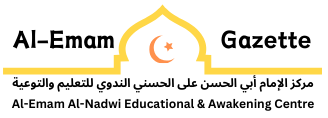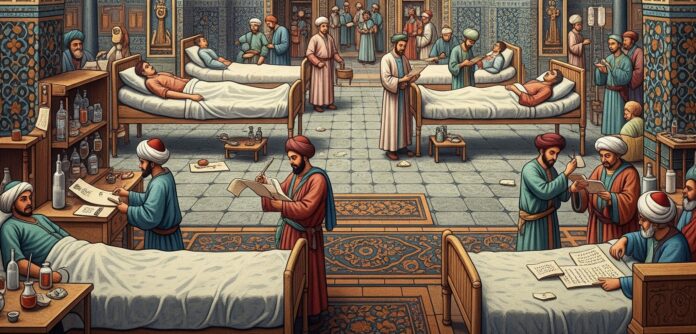The Golden Age of Islamic Welfare Hospitals: A Glimpse through a Patient’s Letter
From the 8th to the 13th century, the Islamic Golden Age flourished, bringing forth advancements that reshaped civilizations. A testament to this era’s unparalleled commitment to human welfare lies in the meticulously described facilities of its hospitals, vividly brought to life in a patient’s letter to his father.
This letter serves as undeniable proof of the sophistication inherent in the welfare-oriented hospitals of that time. It not only paints a detailed picture of the exceptional medical amenities available but also highlights the compassionate and nurturing environment afforded to patients. Beyond mere treatment, the letter speaks of comfortable accommodation, nourishing meals, and even financial assistance upon discharge – a level of care that underscores the profound importance Islamic civilization placed on human well-being. Indeed, the benevolent hospitals of the Islamic era stand as a remarkable exemplar, offering a timeless model for modern healthcare systems.
“Dear father! You asked me if you should bring me money. When I’m discharged, the hospital will give me a new suit of clothes and five gold pieces for the time being so that I don’t have to go back to work straight away. So you don’t need to sell any of your herd. But you must come soon if you still want to find me here. I’m in the orthopedic ward next to the operation theater. When you come through the main portal, you will pass the southern outer hall. That’s the polyclinic where they took me after my fall. Every sick person is first examined there by the assistant doctors and students, and those who don’t necessarily need hospital treatment get their prescription there, which they can have made up in the hospital pharmacy next door.
After the examination, I was registered there and shown to the senior doctor; a guard carried me to the men’s ward, gave me a bath and put me in clean hospital clothes. But you also leave the library and the large lecture hall, where the head physician teaches the students, behind you on your left. The corridor to the left of the courtyard leads to the women’s ward, so you have to keep to the right and walk past the internal medicine department and the surgical ward … If you hear music or singing coming from a room, look inside. I may already be in the day room for the convalescents, where we have music and books to entertain us.
When the head doctor was on rounds this morning with his assistants and attendants and examined me, he dictated something to the ward doctor that I didn’t understand. He told me afterwards that I could get up tomorrow and would soon be discharged. But I don’t want to leave at all. Everything is so bright and clean here. The beds are soft, the sheets made of white damask and the blankets as fluffy and fine as velvet. There is running water in every room and each one is heated when the cold nights come. Almost every day there is poultry or roast mutton for those whose stomachs can take it. My neighbor had been pretending to be sicker than he was for a whole week, just to be able to enjoy the tender chicken breasts for a few days longer. But the head doctor got suspicious and sent him home yesterday after he was allowed to eat a loaf of bread and a whole chicken to prove his health. So come, before my last chicken is roasted!”
We would have no trouble believing the conditions of which the letter speaks to be those of our vaunted 20th century.
In fact, he describes one of the hospitals that were essential facilities in every major Arab city between the Himalayas and the Pyrenees a thousand years ago. Cordoba alone had fifty hospitals in the middle of the 10th century. It even seems to have surpassed the universal model – Baghdad with its famous hospitals from the time of Harun al-Rashid.
The Adudi Hospital in Baghdad, which was laid out in many pavilions, the Nuri Hospital in Damascus, which also had separate buildings for each department, and the pearl of all hospitals, the Mansuri Hospital in Cairo, were the most famous institutions and medical centers in the Arab world. The “Nuri” was built by the humane Sultan Nur ad-Din Zengi (1146-1174), who was very concerned about the welfare of his subjects, from the ransom money of one of the Frankish kings whom he had released from captivity.
Not only caliphs and sultans or wealthy private individuals, but also physicians such as Sinan ben Thabit and Thabit ben Sinan, son and grandson of the famous astronomer Thabit ben Qurra, founded hospitals alongside outpatient medical stations that travelled through the villages and prison hospitals. In 923, the sage Ibn al-Furat used his income to set up a polyclinic in Baghdad especially for his employees, where his staff could receive free medical advice and treatment at all times.
Patients, rich and poor alike, were cared for free of charge. The medical treatment did not cost them a dirham: and they received free accommodation, food, medicine and even a month’s clothing and subsistence allowance when they were discharged.
From Book: Allah’s Sun over the Occident: Our Arabian Heritage
German Writer: Sigrid Hunke
Page No. 2/45
Thank you,
Ahmad Suhaib Nadvi
Al-Emam Gazette
Email: info@al-emam.org
Al-Emam Al-Nadwi Education & Awakening Center
New Delhi, India



